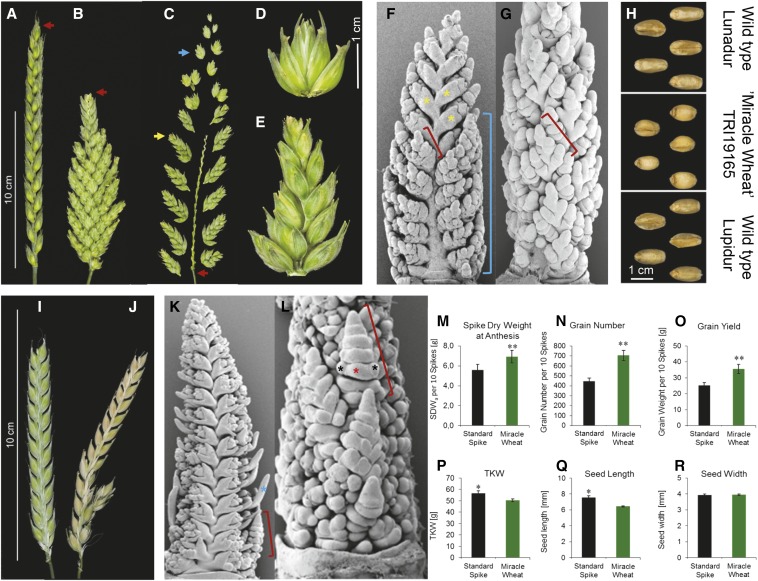Figure 1.
Spike morphology of wild-type and branched (mutant) genotypes in wheat and barley. (A) Hexaploid awnless wheat cv. ‘Kanzler’ with terminal spikelet (red arrowhead) and determinate spike. (B) ‘Wunder-Weizen’ accession TRI 1781 carrying the bht allele displays loss of terminal spikelet (red arrowhead) and indeterminate spike development; awns are removed for clarity. (C) Detached spike’s main axis (red arrowhead), associated single spikelet (blue arrowhead), and multispikelet branch (yellow arrowhead indicates small-sized secondary spike; see also E). (D) Single spikelet containing multiple florets. (E) A multispikelet branch bearing fertile spikelets. (F) Lateral and (G) dorsal view on immature spike from ‘Miracle-Wheat’ TRI 27966 at the terminal spikelet stage showing ectopic branch-like structures emerging from glume primordia (GP, yellow asterisks); blue brackets enclose the branched region along the spike and red brackets delimits early small-sized secondary spike. (H) Seed shape differences (length and width) between two elite tetraploid durum wheat cultivars (top, ‘Lunadur’; bottom, ‘Lupidur’) and ‘Miracle-Wheat’ accession TRI19165. (I) Wild-type barley spike cv. Bowman; awns clipped off for clarity. (J) A branched spike of com2-type barley in BW-NIL(com2.g). (K) Lateral and (L) dorsal view of immature BW-NIL(com2.g) mutant spike at the AP stage (AP, blue asterisk), red bracket delimits early developmental stage of small-sized secondary spike, and red and black asterisks in L represent central and lateral SMs, respectively, of secondary spike. (M–R) Comparison of yield components between elite durum wheat cultivars and ‘Miracle-Wheat’ accessions in the field. Data are based on averages of 200 spikes per phenotypic class. Asterisks indicate significant difference between pairwise comparisons as calculated by Student’s t-test at 95% (*) and 99% (**) confidence intervals.

